Sapin-Sapin is as tasty as it is pretty! Soft, chewy, and topped with golden latik, this Filipino steamed glutinous rice cake is a delicious midday snack or after-dinner dessert.
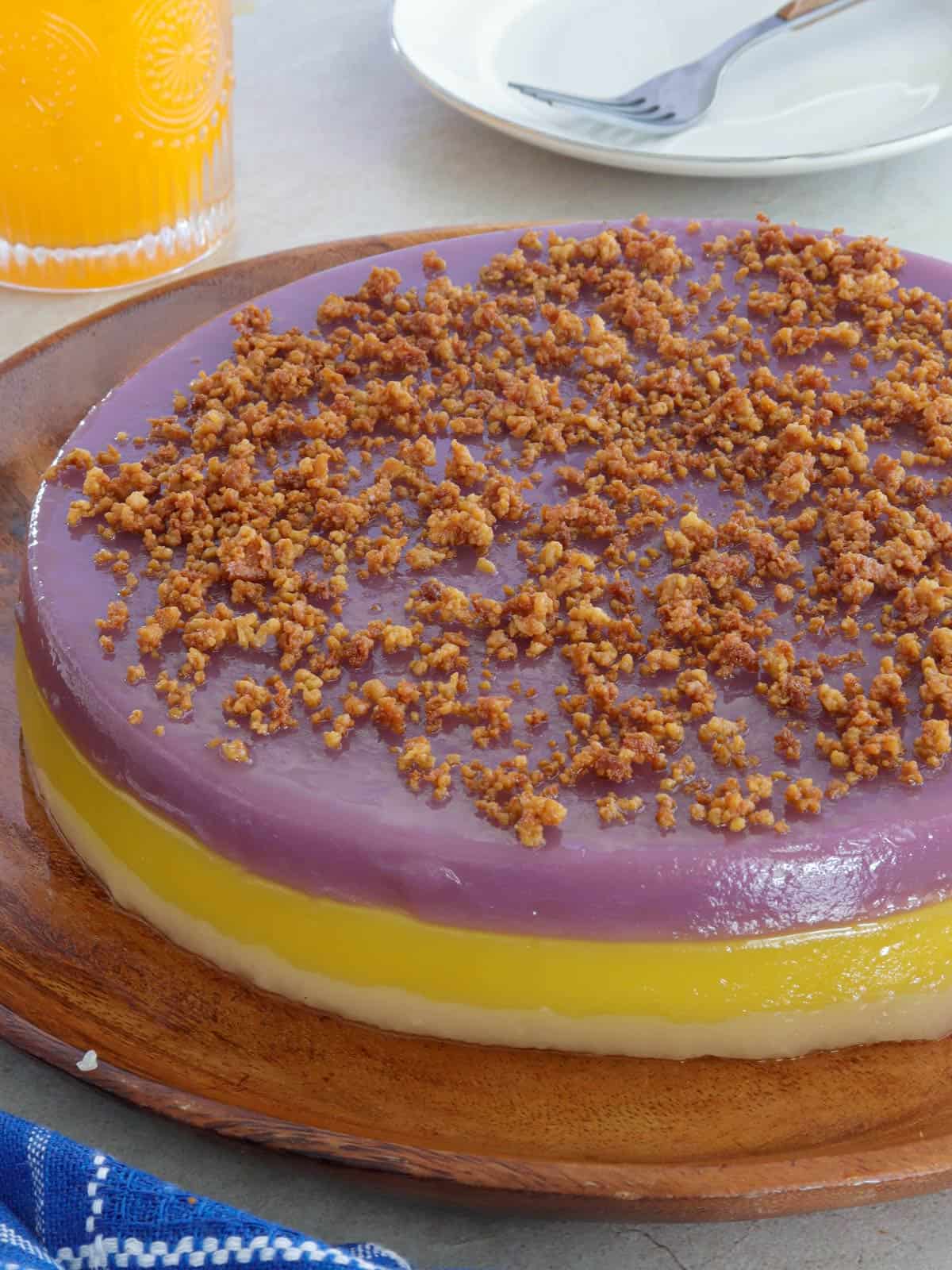
I've wanted to make sapin-sapin for the longest, but I was intimidated by what I thought to be a very complicated process. So when I went home to the Philippines a few years ago, I asked our suking magkakanin to teach me, along with other kalamay recipes like Palitaw, Kapit, Royal Bibingka, and Kalamay Hati.
As it turned out, I didn't need a 7,185-mile trip to learn how to make this Filipino steamed cake. The whole process is easy; it's almost child's play!
Ingredient list
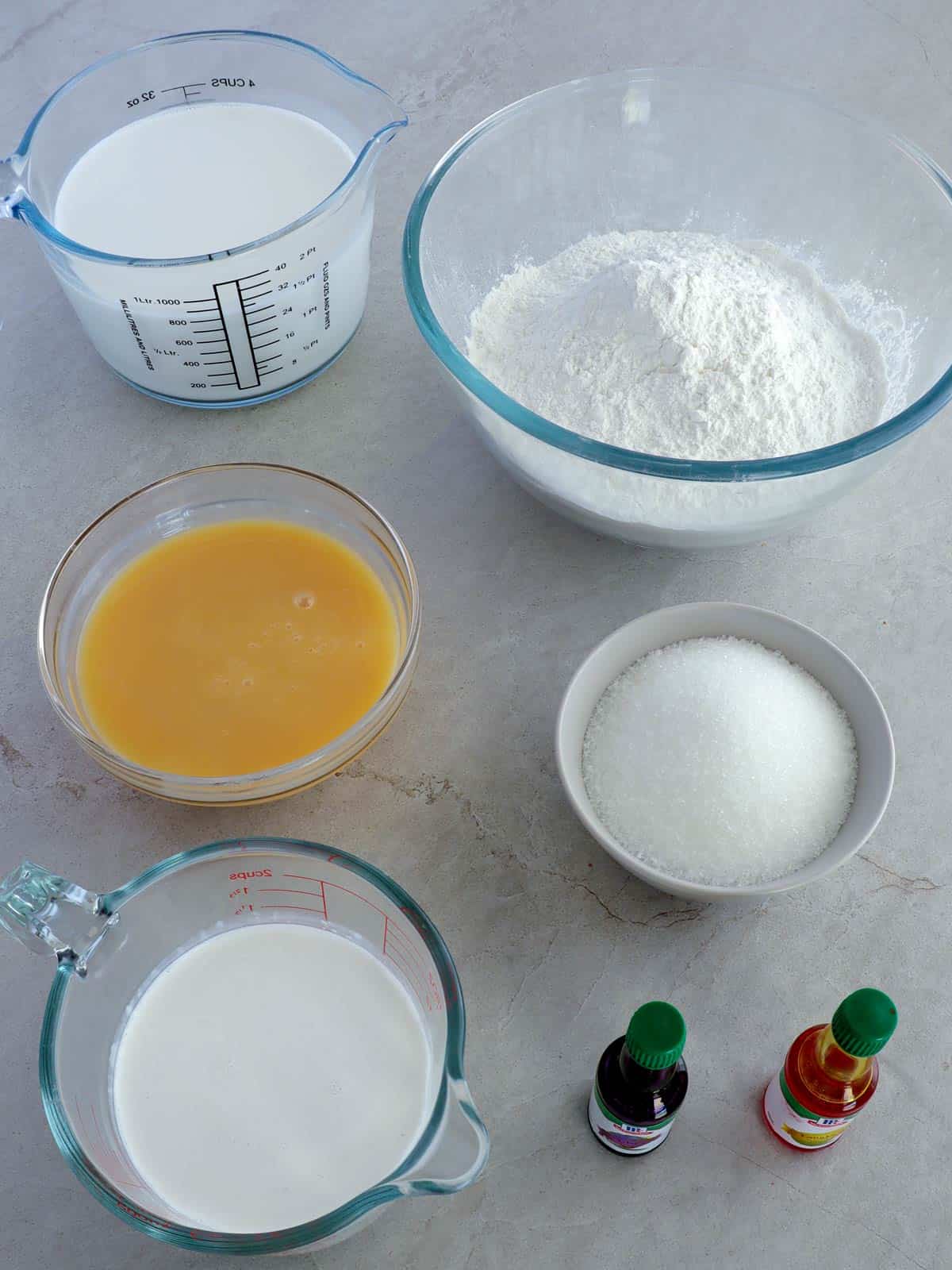
- Coconut cream - also called kakang gata, is used to make the latik topping. As it's the first extraction from grated coconut and is thicker, richer, and creamier, it will reduce quicker.
- Glutinous rice flour- Locally known as malagkit. Also called sticky or sweet rice flour, it gives the dish its signature chewy texture. The steamed kalamay is traditionally made by soaking rice grains in water overnight to soften them and then grinding them into a thick batter or galapong mixture. Using rice flour makes the process so much easier.
- Coconut milk- adds a rich, creamy taste to the batter. You can use freshly pressed or canned for convenience.
- Condensed milk- a dense liquid made from cooking down milk to remove its water content. It adds sweetness and creaminess.
- Sugar- add more or less to adjust the level of sweetness to your liking
- Flavor extracts- the recipe uses ube and langka extracts to add color and flavor.
Prepare the pan
- The rice batter is about 6 cups which fits perfectly in an 8 x 2 round baking pan. You can also use an 8 x 8 square pan with an 8-cup capacity. Or a springform pan to make releasing the sticky rice cake easier.
- Liberally grease the inner sides and bottom of the baking pan to be able to remove the sticky rice cake easily after steaming. You can also use wilted banana leaves to line the pan or parchment paper.
Sapin-sapin cooking steps
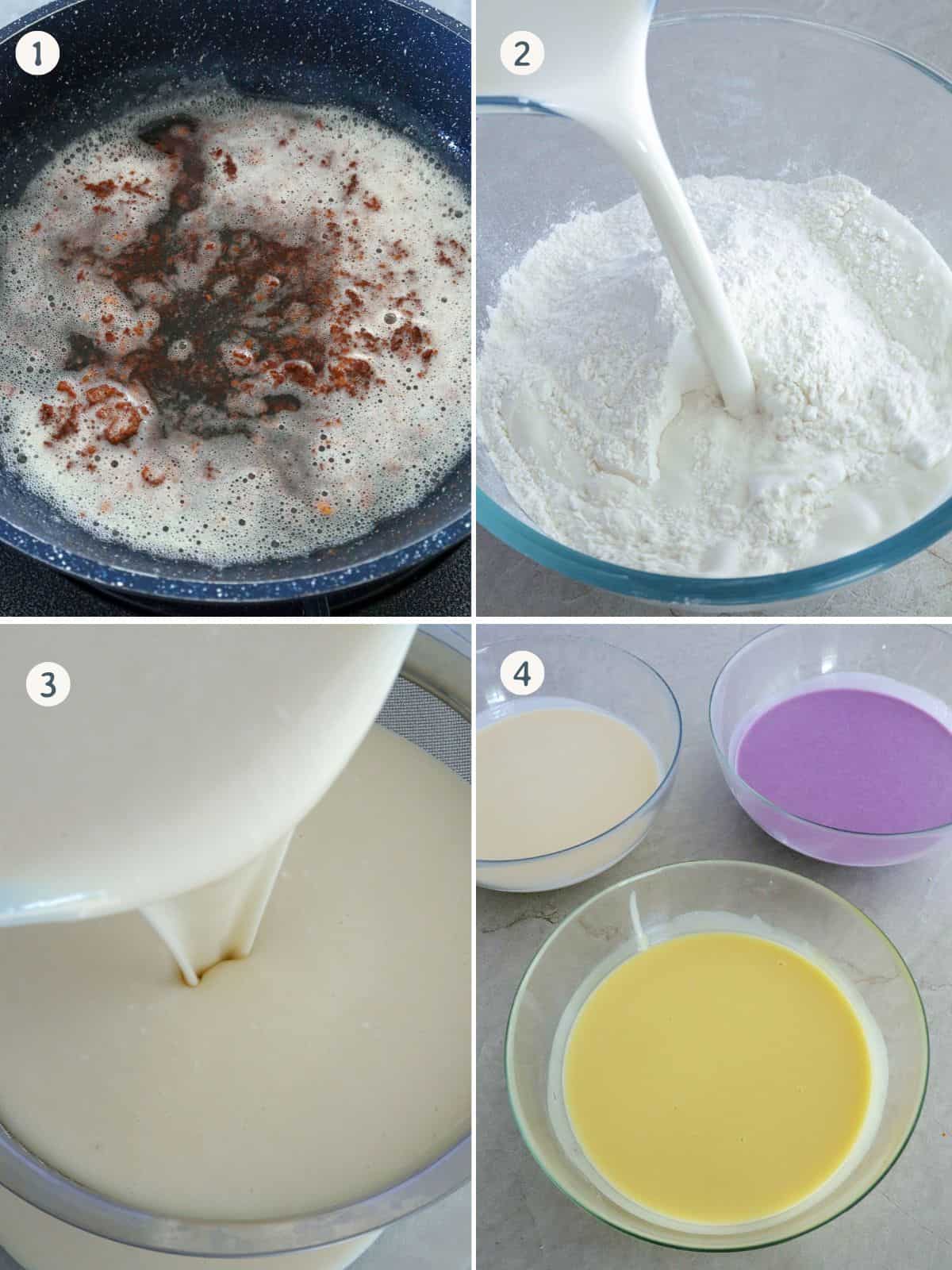
Sapin-Sapin, which means layers, is one of the easiest Filipino desserts you can make. It's so much fun watching everything come together into one colorful sweet treat! You'll be amazed at how something so gorgeous and delicious can be put together with minimal effort.
- Make the latik- check out my tutorial on how to make latik for detailed steps and tips. Drain the coconut curds well and store them separately from the coconut oil until ready to use. While you can use toasted coconut shreds instead, I urge you to make the extra effort. The latik taste so much better, and the rendered oil can be brushed on the sapin-sapin to add aroma and flavor.
- Make the batter- combine the glutinous rice flour, coconut milk, condensed milk, and sugar in a large bowl. Stir together until the sugar is dissolved and the mixture is smooth and well blended.
- Strain the batter- run into a fine-mesh sieve to remove any lumps and divide evenly into three bowls.
- Add the extracts- stir the ube in one bowl and the langka in another bowl until well dispersed, leaving the third portion plain and white. I use about 3 to 4 drops of each extract to achieve the color I like. Note that the colors of the tinted batters will be light but will deepen when steamed and cooked.
- Steam the batter- pour and steam each colored batter individually on top of each other until a toothpick inserted in the center comes out clean.
- Cool- remove the cake from the steamer and allow it to cool completely to make it easier to release from the pan. Run a knife around the sides of the pan to loosen the rice cake. Do not cover the kalamay until sufficiently cooled, as the steam will cause water puddles on the cake.
- Serve- carefully invert the pan on a wide platter and tap a few times to release the sapin-sapin onto the platter (the purple layer will now be the top layer). Liberally brush with coconut oil, sprinkle latik on top, and cut into serving portions.
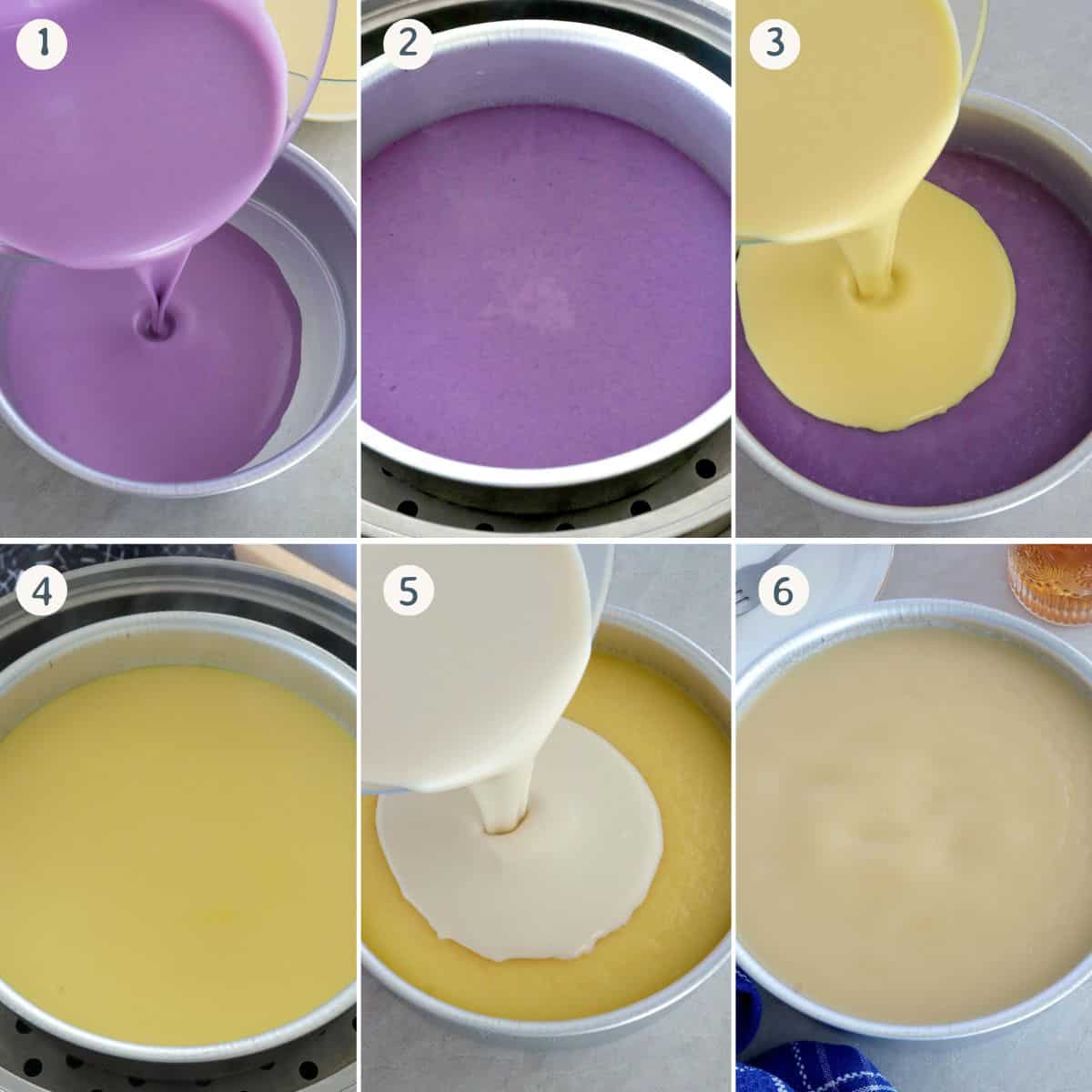
Cooking tip
To make the sapin-sapin extra special and more traditional, stir in about ½ cup of mashed cooked ube to the purple-colored mixture, ¼ cup of finely chopped jackfruit (langka) to the yellow-colored mixture, and ¼ cup chopped macapuno strips to the white mixture.
Frequently Asked Questions
What is the meaning of sapin-sapin?
Sapin-sapin literally means "sheets or layers" in the Filipino language. The name comes from the process of steaming the colored layers on top of each other.
What are the characteristics of sapin-sapin?
It's a multi-layered sticky rice cake with various flavors and coloring, such as ube and langka. This steamed kakanin is soft and chewy with a hint of coconut flavor from the use of glutinous rice flour and coconut milk. It's traditionally topped with latik or toasted desiccated coconut.
What is the history of sapin-sapin?
The word kakanin is derived from the word "kanin" and is the blanket term for Filipino delicacies made of rice. Sapin-sapin is a type of kakanin that originated in the Northern province of Abra and has spread in popularity throughout the country.
Does it need to be refrigerated?
Yes! As the kalamay is made of coconut milk, it can spoil quickly, especially in warmer weather. Allow it to cool completely before covering, as the escaping steam might cause water puddles on top of the cake. Refrigerate for up to 3 days. When ready to serve, warm up in the microwave for a few seconds to soften.
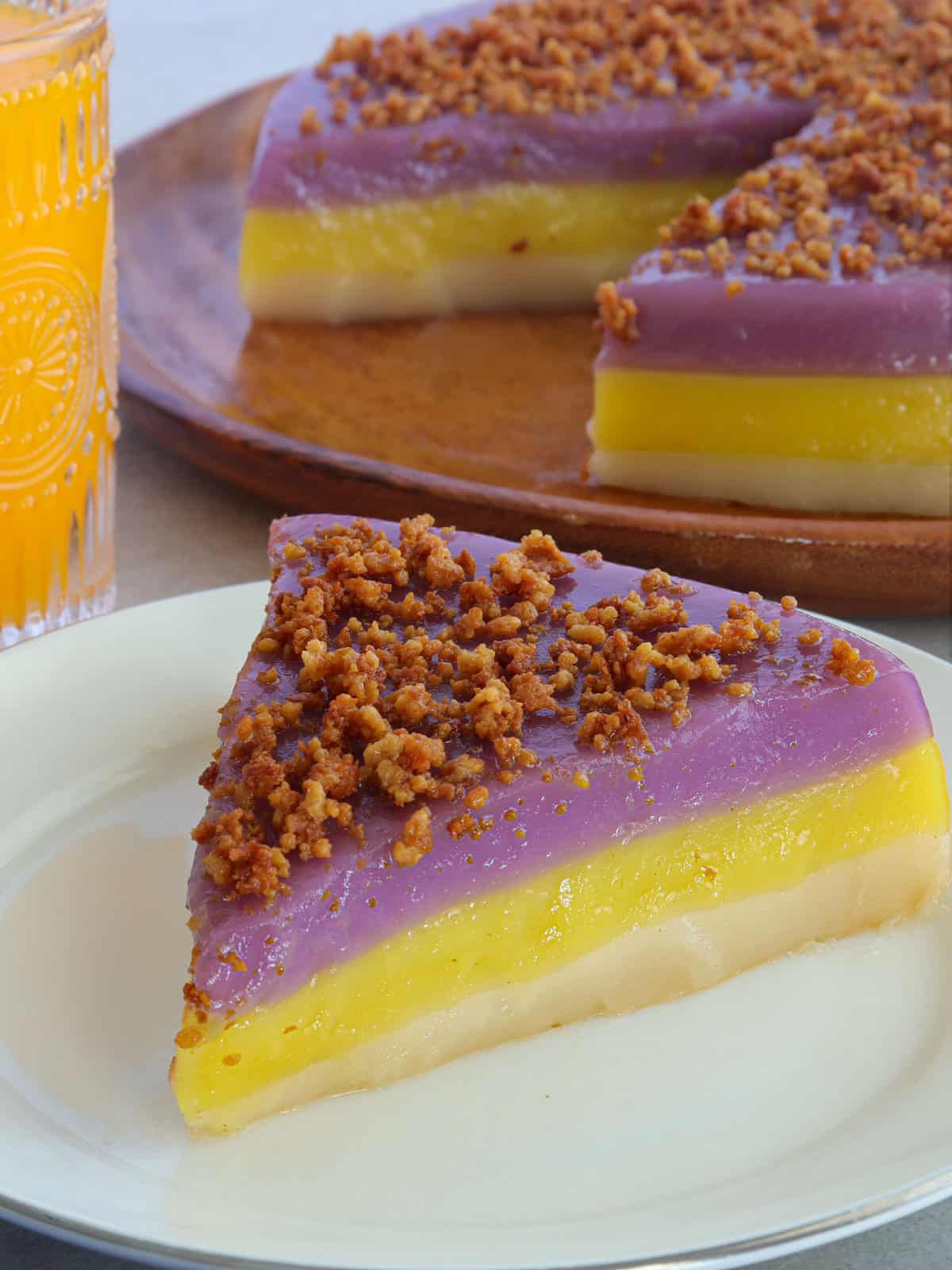
Serving suggestions
Sapin-sapin is a tasty and filling midday snack or after-meal dessert. Slice into wedges and enjoy it with coffee, tea, tsokolate, or cold sago at gulaman!
Ingredients
For the Latik
- 1 cup coconut cream (kakang gata)
- 3 ½ cups glutinous rice flour
- 2 cans (13.5 ounces each) coconut milk
- 1 can (14 ounces) condensed milk
- 1 cup sugar
- 3 drops ube flavor extract
- 3 drops langka flavor extract
Equipment
Equipment
- Steamer
- 8x2 round pan
Instructions
- In a pan over medium heat, add coconut cream and bring to a boil. Cook, stirring occasionally until liquid starts to thicken.
- Lower heat and continue to cook. As oil starts to separate and solids begin to form, regularly stir and scrape sides and bottom of the pan to prevent from burning. Continue to cook and stir until curds turn golden brown.
- Drain latik from the oil and store in separate containers until ready to use.
- Generously brush inner sides and bottom of an 8-inch round baking pan with the oil.
- In a large bowl, combine glutinous rice flour, coconut milk, condensed milk, and sugar. Stir together until sugar is dissolved and mixture is smooth and well blended.
- Strain the batter using a fine-mesh sieve and divide evenly into three bowls.
- In one bowl, add ube extract and stir until color is well dispersed. In another bowl, add Langka extract and stir until color is well dispersed. The remaining portion will be white and plain.
- Pour ube-flavored batter into the prepared baking pan. Steam for about 10 minutes or until set and toothpick inserted comes out clean.
- Carefully pour langka-flavored batter over purple layer. Steam for about 10 minutes or until set and toothpick inserted comes out clean.
- Gently pour plain batter over yellow layer. Steam for about 10 minutes or until set and toothpick inserted comes out clean.
- Remove cake pan from steamer and allow to cool completely.
- Run a knife around the sides of the pan to loosen the rice cake. Place a wide, flat serving platter over cake pan and gently invert. Tap the pan a few times to release the sapin-sapin onto the platter (purple layer will now be the top layer).
- Liberally brush top and sides of sapin sapin with coconut oil. Sprinkle latik on top and cut the cake into serving portions.
Notes
- The rice batter is about 6 cups which fits perfectly in an 8 x 2 round baking pan. You can also use an 8 x 8 square pan with an 8-cup capacity.
- For easy removal of steamed cake, liberally grease the inner sides and bottom of the baking pan. Or use wilted banana leaves to line the pan or parchment paper.
- To make the sapin-sapin extra special, stir in about ½ cup of mashed cooked ube to the purple-colored mixture and ¼ cup finely chopped jackfruit (langka) to the yellow-colored mixture.
- Allow the kalamay to cool completely before covering, as the escaping steam might cause water puddles on top of the cake.
Video

Nutrition Information
“This website provides approximate nutrition information for convenience and as a courtesy only. Nutrition data is gathered primarily from the USDA Food Composition Database, whenever available, or otherwise other online calculators.”

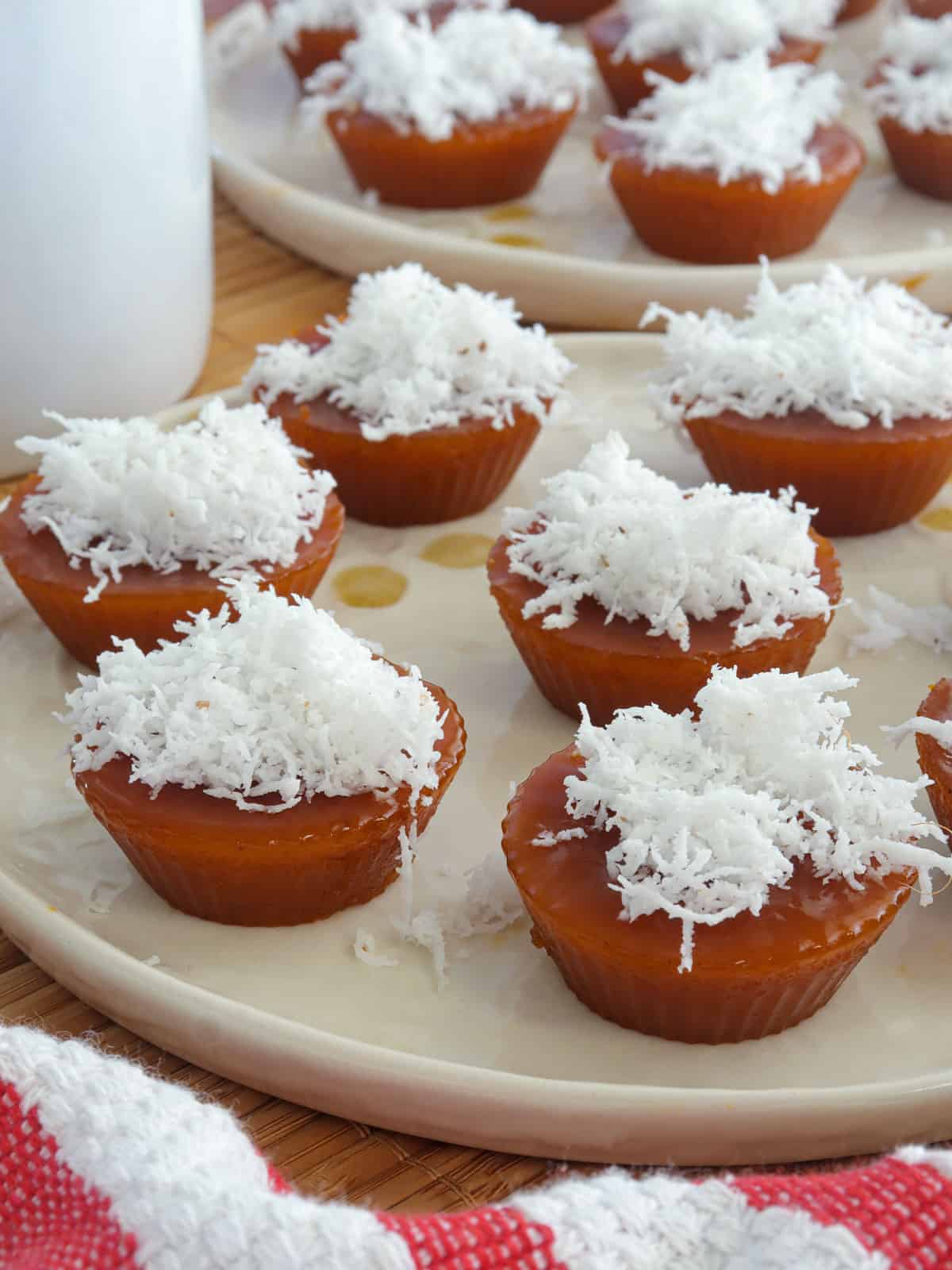
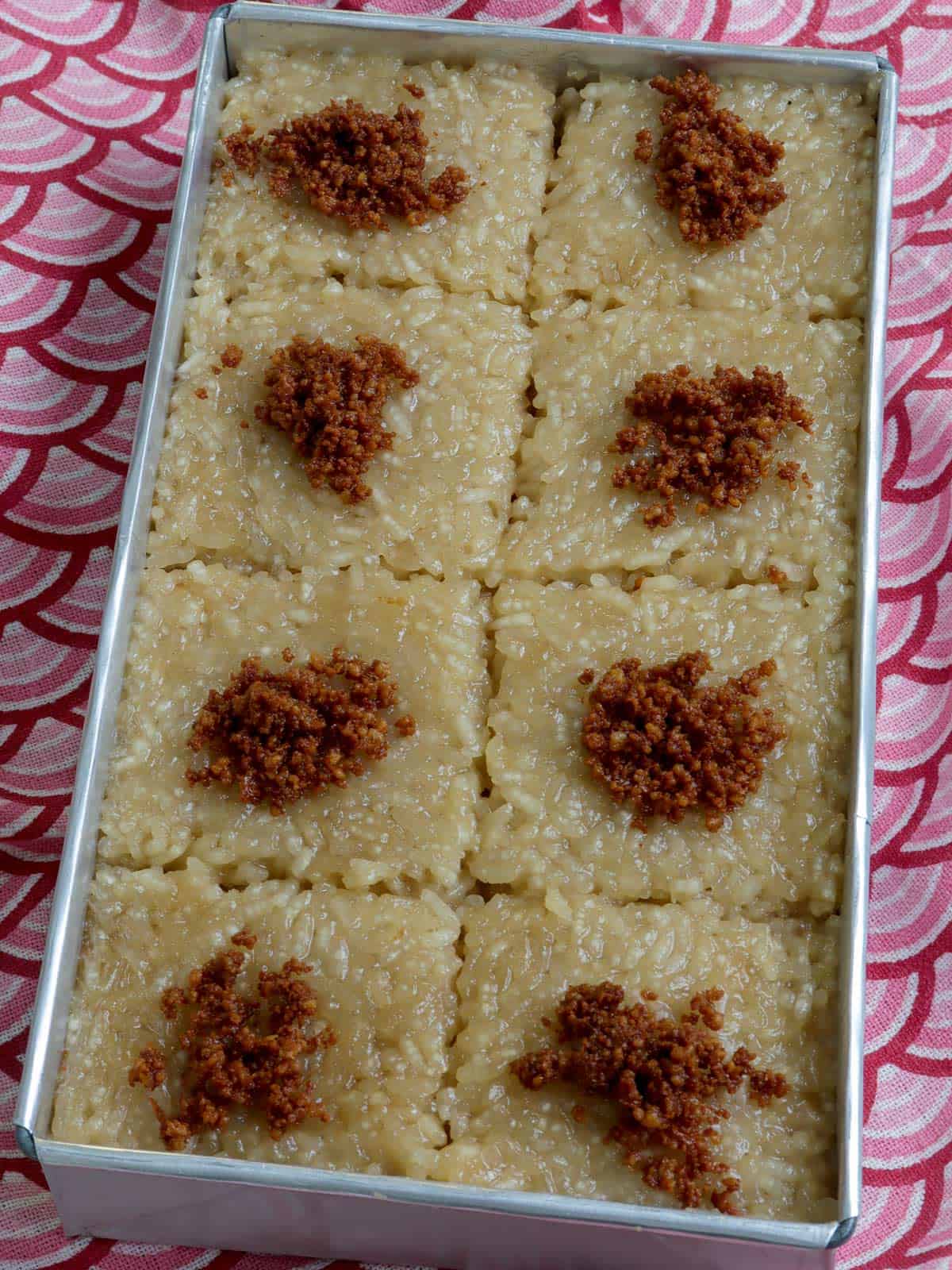

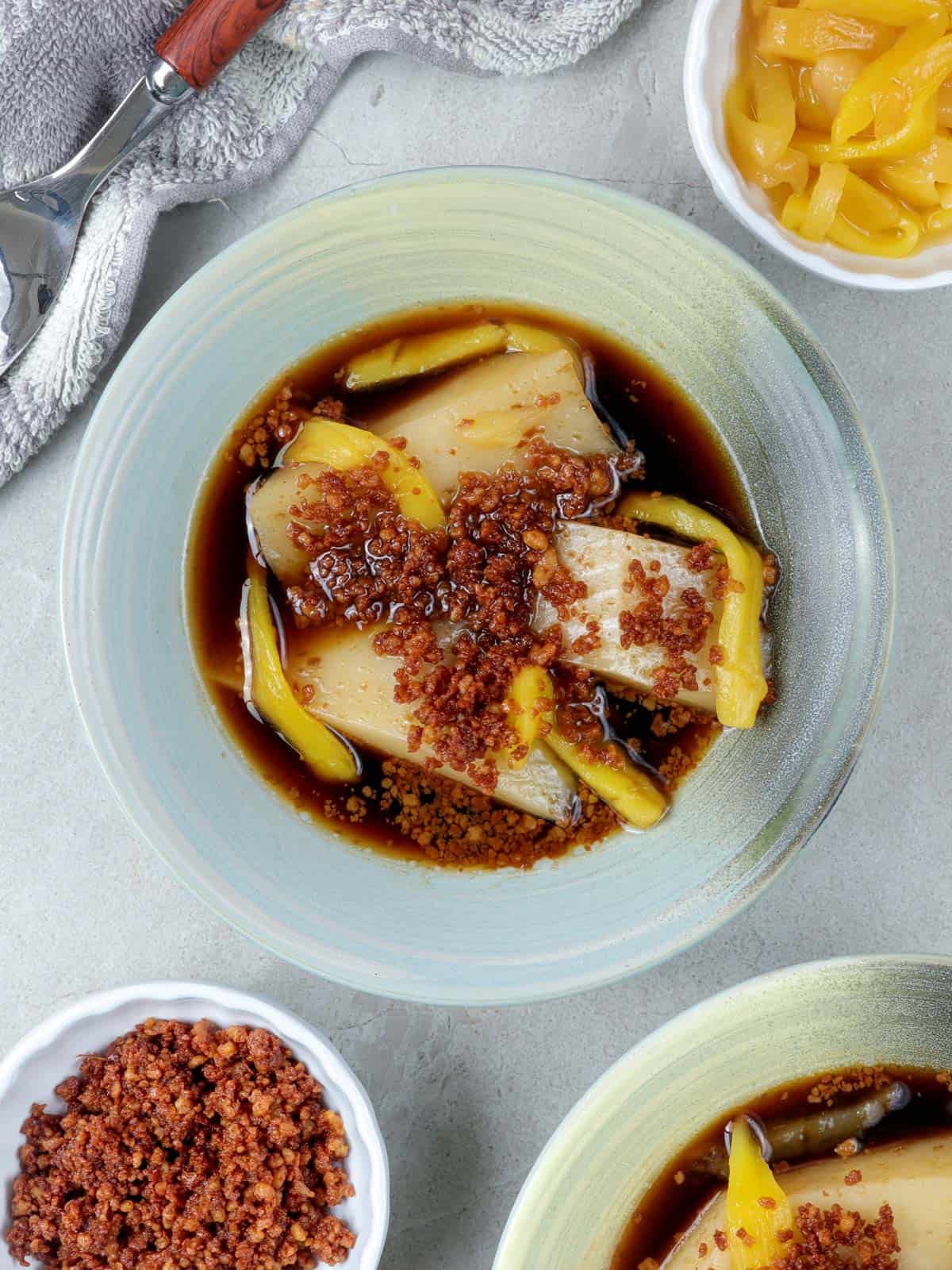
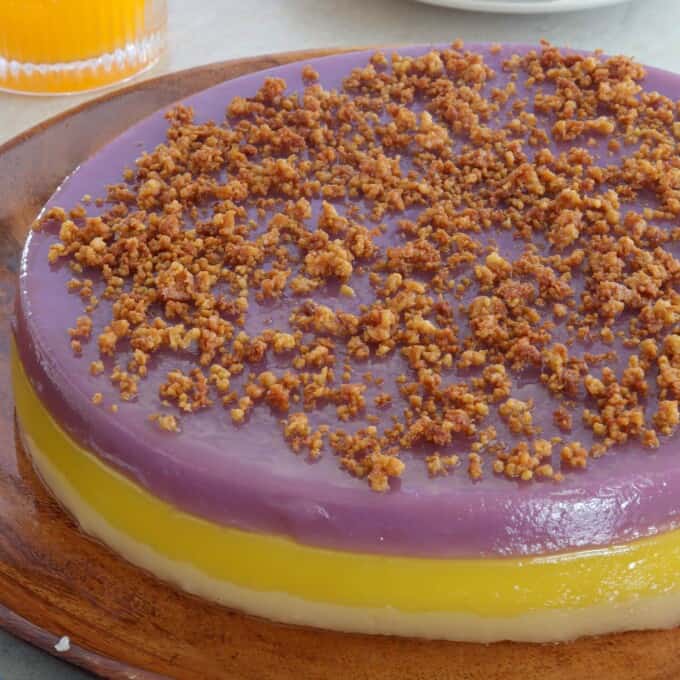
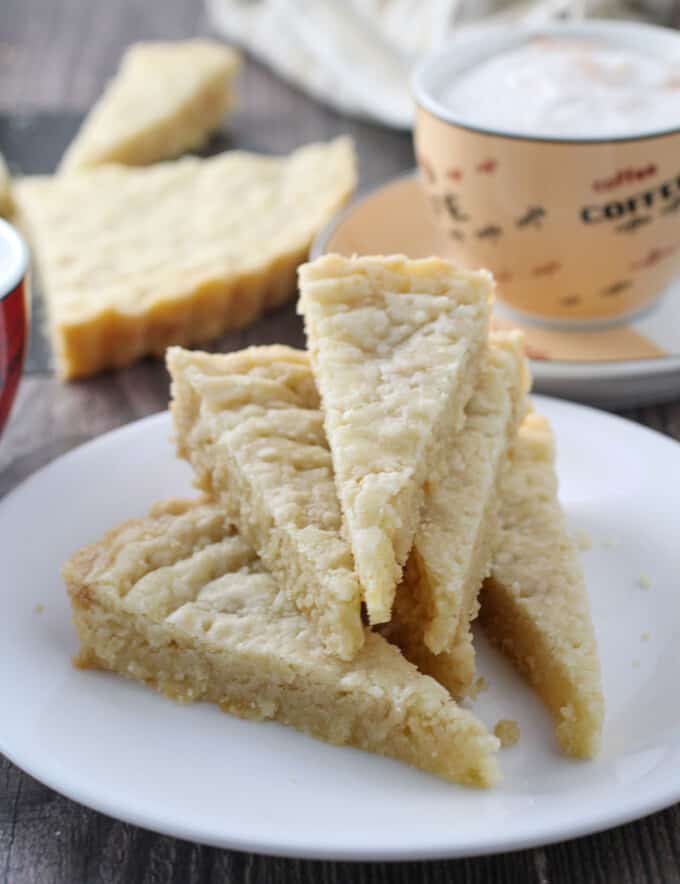
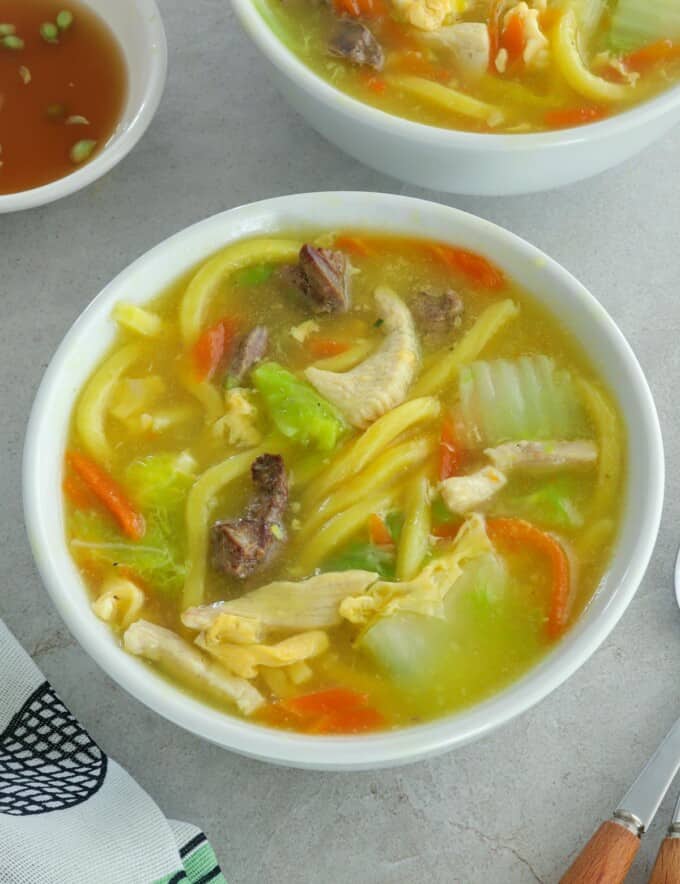
Bonzay says
Super gummy ng nagawa ko
Lalaine says
When you say super gummy does it mean chewy or medyo matigas? I am sorry to hear the recipe didn't work well for you. The kakanin should be sticky but still soft.
SofiA nicolas says
Mam lalaine, do you have a recipe of sapin sapin without condensed milk? Tnanks in advance
Lalaine says
Unfortunately, I don't have one yet without the condensed milk. You can omit it if you like and just a bit more coconut milk and sugar to the batter.
Anna says
Hi, is it OK to use gluten-free rice flour? Thanks!
Lalaine says
Hello Anna,
All brands of rice flour are naturally gluten-free, rice doesn't contain gluten. Wheat and cereal grains have gluten 🙂
cherry says
hanggang ilang araw po ang itatagal nito pag hndi naka ref?
Lalaine says
Hi, Cherry,
Unfortunately, it won't last long outside of the refrigerator because of the coconut milk, especially in hot weather. I forgot mine on the counter before and it already tasted sour after a few hours.
Ailyn says
My nkalagay nmn po 3cups glutinous flour
MayBe says
Hi Ms. Lalaine!
In the picture, did you use a pie pan? it looks nice and it will perfectly fit in my steamer. 8x8 cake pan can't fit in my steamer.
Happy New Year!
Lalaine says
Hi Neighbor,
Yes, I used a pie pan 🙂
Deena says
Hi Lalaine,
Is it ok to use canned coconut milk and cream instead of the fresh ones?
Lalaine says
Hi Deena,
Yes, that is what I use here because I don't have access to freshly-squeezed coconut milk/cream like from markets in the Philippines 🙂
EMILY PILEO says
FULL OWNERSHIP
Stephan says
This looks sensational...and easy....I love exotic Asian rice desserts which look complicated and wow the guests; and yet are straightforward. And while not exactly simple are certainly not hard to make.
I love the sticky Black Rice puddings of Indonesia, and have been to a number of feasts where 'secret' Filipine recipes have been liberally given. Often and always expressing the love of the cook AND ( perhaps more importantly) the transmission of loving family recipes passed down through generations.
I am not Filipino, but have some joyous contacts with the community. I love the sense that food expresses community and love.
I am actually Australian born in England....but am possibly a reincarnated Asian food lover.
I have three lovely daughters who are all great cooks...especially of exotic desserts.
I am looking forward to making this great dessert for them (and glad it is easy...but looks fantastic!)
Great blog
Lalaine says
Thank you, Stephan. I hope you enjoyed this recipe!
Emma says
Like to make ahead of time and serve on xmas day..Can you freeze sapin sapin?
Lalaine says
I've never tried it myself but I've seen sapin sapin sold in stores here and they're kept in the freezer. I am not sure, though, if there will be a change in texture. It might be okay as this is like mochi (made of rice flour) and mochi seems to freeze well.
Wengki says
Madam, can I use the oven in cooking sapin sapin instead of steamer?
Lalaine says
Hello Wengki,
You can do a baine marie https://en.wikipedia.org/wiki/Bain-marie if you want to do it in the oven. 🙂
nicetas says
Mam, what could be used as substitute for rice flour? Here in our province we only have malagkit rice.is it okay if i have it ground with some water, then add sugar & coconut milk? Will I achieve a perfect sapin sapin, what is the measurement?
Carolyn says
Is there a way to make langka flavor extract at home? or can it be replaced with jackfruit juice?
Lalaine says
Hi Carolyn
You can use the langka juice as part of the liquid for the yellow part and maybe use food color to get the desired shade.
carolyn says
Thank you!! I finally made made this dessert and it was the best sapin sapin I've had! So much flavor 🙂
Lalaine says
Thanks, Carolyn. I am glad you enjoyed it. 🙂
Judith Uy says
I just love this recipe , easy to follow and yummy. More power and. More recipes to cook . Thank you for sharing
Lalaine says
You're welcome, Judith. I am glad you liked it 🙂
Djc says
Hi, what if I have a 5 layer steamer, can I steam them all on one time?
Lalaine says
Hello!
You can't steam all the different layers at one time because they go on top of each other. You cook them in one pan so you can't steam them at the same time. If you cook all the separately and try to assemble them after, they won't stick together like a sapin sapin should.
Dan says
Ilang cups po ang rice flour? It's not listed po kasi sa ingredients pero nasa instruction. And how do you measure the flours? By "spoon and level" or packed? Thank u.
Lalaine says
Hi Dan
It's supposed to read "glutinous rice flour", I corrected the recipe to reflect this. No, I didn't spoon and level ( Unfortunately I am not a very disciplined or precise cook). I just scooped from the bag and leveled it off.
jordan Lastimosa says
Ms.Lalaine . pede b gumamit ng plastik na panghulmahan instead of tray or pan
Lalaine says
Yes, you can. Just make sure to grease the pan with coconut oil or butter para wag dumikit yung sapin sapin.
Olie says
Hi there! I love your blog! And the way you make your recipe since it is so similar to how my parents does it...Capampangan blood can be seen in similarities in taste and ways of cooking. I think I've mention that before in my first comment to you about a month ago when I first found your blog. Anyway, your sapin sapin looks amazing. My sister in law makes a mean sapin-sapin like this. She always would recite to me how she does it, but we never had the chance to get together, and I learn from her hands on. She always said it's easy, but like you before I am intimidated by it. Thus I am so happy you took the courage to make and post this. Question though: what are the exact ingredients of the Ube and Langka flavor extract from the bottle? You see my children have severe allergies from gluten, casein, artificial coloring, preservatives, etc...yeah so pretty much I make everything from scratch. I have a feeling th Ube extract is aritificial? And I looked at the Langka linked to Amazon and it says Halal but it doesn't mean much as Halal is mostly helpful if a product is made of meat. I really want to make this as my teenager son and pre teenager daughter has really gravitated with Filipino food and they're voracious with anything Filipino food as long as it is GFCF and Feingold diet standard. Can you please help me with this? Thank you so much.
Lalaine says
Hello Olie
Thank you so much for your kind words. I am glad you find Kawaling Pinoy useful in your homecooking.
Yes, sapin sapin is a lot easier than I thought. I hope you can try it sometime. Unfortunately, this is does not meet GFCF standard as although it's wheat free (I used rice flour), it has dairy. You can, however, eliminate the condensed milk and just add more coconut milk and sugar. I don't think it's Feingold safe as well as I used flavor extracts with food coloring and propylene glycol. You can maybe, go with having the sapin sapin plain? I know it won't be as pretty and not as much fun to eat but you still get the enjoyment of a delicious rice cake.
Let me know if there is anything else I can help you with.